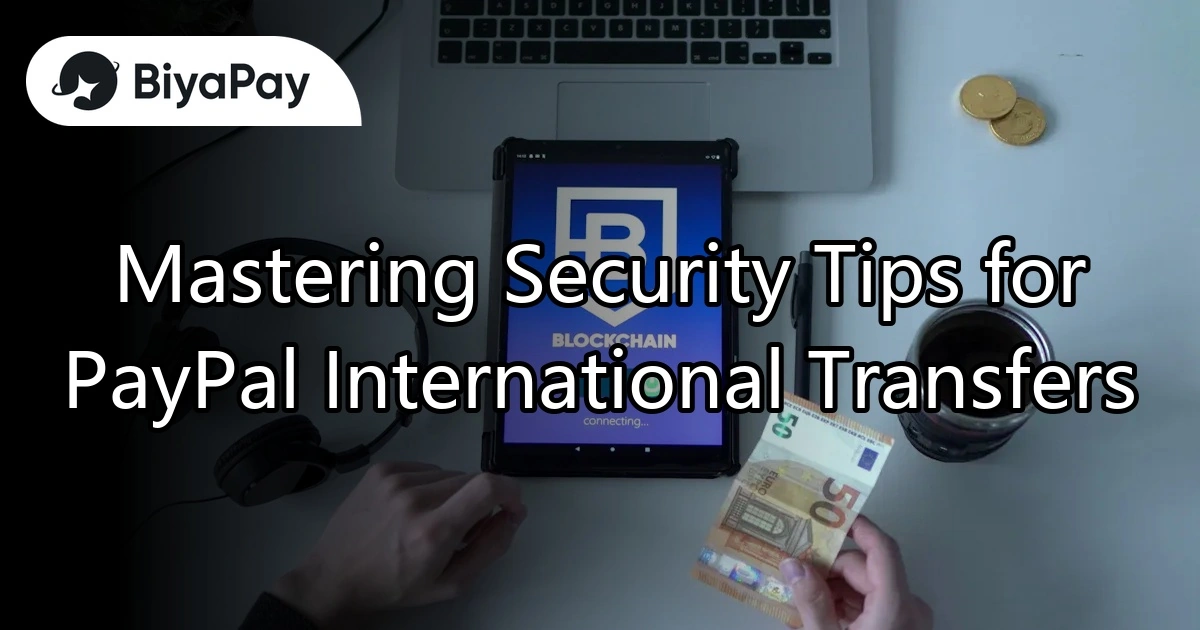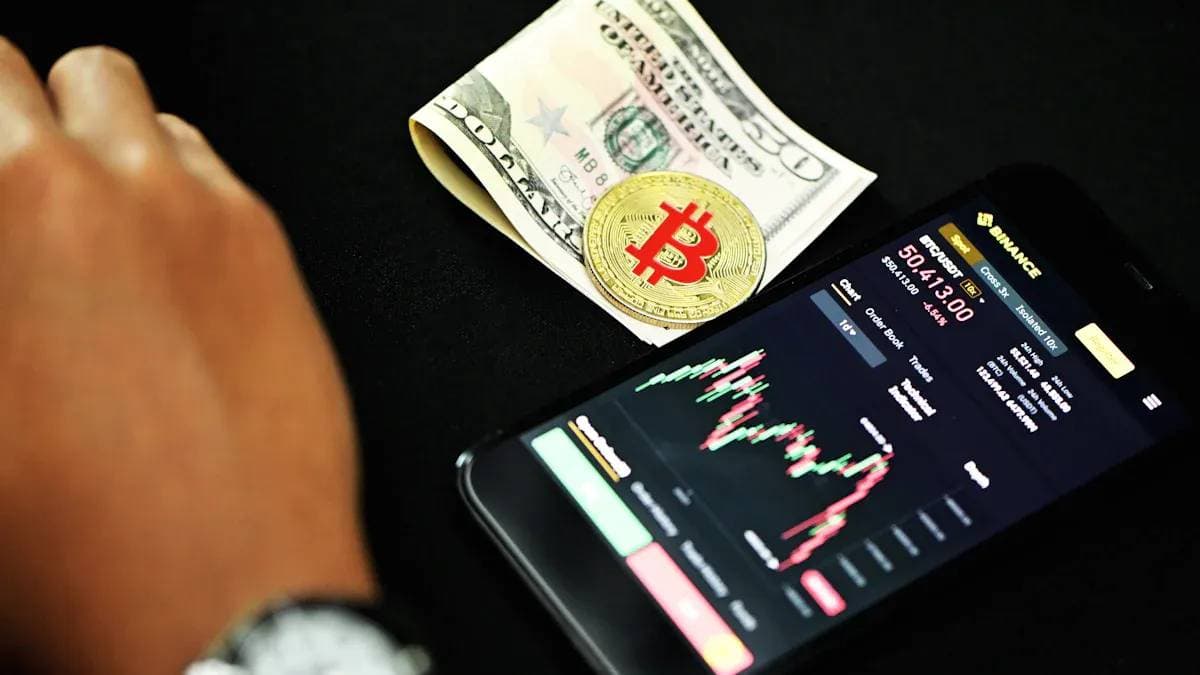- EasyCard
- Trade
- Help
- Announcement
- Academy
- SWIFT Code
- Iban Number
- Referral
- Customer Service
- Blog
- Creator
Mastering Security Tips for PayPal International Transfers

Image Source: pexels
In cross-border remittances, safety and convenience are often difficult to balance. When using PayPal international transfers, you can achieve both. PayPal protects user funds with advanced technology, such as data encryption and real-time transaction risk monitoring. These features allow you to enjoy efficient transfers while avoiding potential cyber threats. By mastering a few simple techniques, you can further enhance your account’s security in daily operations.
Key Points
- Use a strong password and update it regularly to ensure account safety. A strong password should include uppercase and lowercase letters, numbers, and special characters, with a minimum length of 12 characters.
- Enable two-factor authentication to enhance account protection. Each login requires a dynamic verification code to prevent unauthorized access.
- Regularly check account activity logs to promptly detect unusual transactions. Make it a habit to review them weekly to ensure account safety.
- Avoid using PayPal on public Wi-Fi; use a secure network to protect account information. Use a VPN when necessary to enhance data encryption.
- Save frequently used recipient information to improve transfer efficiency. This allows quick selection of contacts, saving time.
Overview of PayPal International Transfer Security
Application of High-Strength Encryption Technology
PayPal international transfers use advanced encryption technology to ensure your data is not stolen during transmission. For each transaction, PayPal applies high-strength encryption to your information, preventing hacker attacks. You can confidently enter personal and financial information, as this data is protected in a secure environment. The use of encryption technology provides double protection for your funds and privacy.
Advantages of Multi-Factor Authentication
Multi-factor authentication is a key feature of PayPal international transfers. After enabling this function, you need to provide additional verification information, such as a mobile verification code or fingerprint recognition. This mechanism enhances account security, making it difficult for someone to log in even if they obtain your password. You can further reduce the risk of account theft by setting up two-factor authentication.
Anti-Fraud Technology and Risk Control System
PayPal has robust anti-fraud technology and a risk control system, monitoring every transaction in real time. The system automatically detects unusual activities, such as frequent large transfers or operations from high-risk regions. Upon detecting suspicious behavior, PayPal immediately takes measures to protect your account. Additionally, PayPal offers buyer and seller protection plans, helping you mitigate risks in transactions. To minimize risks, you can follow these suggestions:
- Adhere to PayPal’s transaction rules.
- Maintain good account credibility.
- Handle large transactions with caution.
- Fully utilize PayPal’s protection measures.
Through these technologies and measures, PayPal international transfers provide a secure and reliable payment environment.
Practical Tips for Ensuring PayPal International Transfer Security

Image Source: pexels
Create a Strong Password and Update It Regularly
Creating a strong password is the first step in protecting account security. You should choose a password that includes uppercase and lowercase letters, numbers, and special characters, with a minimum length of 12 characters. Avoid using common words or personal information, such as birthdays or names. A strong password can effectively prevent hackers from breaching your account through brute-force methods.
Additionally, regularly updating your password is equally important. It is recommended to change your password every three months and ensure the new password is completely different from the old one. You can use a password manager to generate and store complex passwords, which is both secure and convenient.
Tip: Do not reuse the same password across multiple accounts, as this increases security risks.
Enable Two-Factor Authentication
Two-factor authentication adds an extra layer of protection to your account. Once enabled, each login requires you to enter your password and a dynamic verification code. This code is typically sent to your phone via SMS or an authentication app. Even if someone obtains your password, they cannot log in without the verification code.
You can easily enable two-factor authentication in the security settings of your PayPal account. This simple step can significantly reduce the risk of account theft.
Note: Ensure your phone number is up to date to avoid issues receiving verification codes.
Identify and Avoid Phishing Emails and Scam Links
Phishing emails and scam links are common tactics used by cybercriminals. They may impersonate PayPal officials to trick you into clicking links or providing sensitive information. You need to learn to identify these threats.
- Check the sender’s email address. Official PayPal emails typically end with “@paypal.com.”
- Do not click on suspicious links in emails. You can log in directly to the PayPal website to check account information.
- Be cautious if you receive emails requesting passwords or financial information. PayPal will not ask for such details via email.
Suggestion: If you suspect a phishing email, forward it to PayPal’s official anti-fraud email (phishing@paypal.com) for reporting.
By applying these practical tips, you can effectively enhance the security of PayPal international transfers and avoid unnecessary risks.
Regularly Check Account Activity Logs
Regularly checking account activity logs is an essential step in ensuring account security. By reviewing transaction records, you can promptly detect any unusual activities, such as unauthorized transfers or login attempts. PayPal provides detailed account activity logs, which you can easily access in your account settings.
Here are some practical suggestions for checking account activity logs:
- Review Records Weekly: Make it a habit to check records regularly to ensure all transactions are under your control.
- Monitor Unusual Transactions: If you notice transfers or login records from unknown sources, take immediate action.
- Use PayPal’s Notification Feature: Enable transaction alerts to stay informed about account activity in real time.
Tip: If you detect suspicious activity, change your password immediately and contact PayPal customer service. Prompt action can prevent greater losses.
By regularly checking account activity logs, you can proactively protect your account and prevent potential risks.
Use a Secure Network for Operations
When using PayPal international transfers, ensuring the security of your network environment is critical. Public Wi-Fi, while convenient, often lacks necessary encryption, making it vulnerable to hackers. To protect your account information, always use a secure network for operations.
Here are some best practices for network security:
- Avoid Public Wi-Fi: Refrain from logging into your PayPal account or making transfers in public places like cafes or airports.
- Use a VPN: If you must use a public network, enable a Virtual Private Network (VPN) to add an extra layer of encryption to your data.
- Secure Your Home Network: Set a strong password and enable encryption on your router to prevent unauthorized access
Note: When using mobile devices, ensure you install the latest system updates and security patches to reduce vulnerability risks.
By using a secure network, you can significantly reduce the likelihood of your account information being stolen, further enhancing the security of PayPal international transfers.
Suggestions for Improving PayPal International Transfer Convenience
Save Frequently Used Recipient Information
When making frequent international transfers, saving commonly used recipient information can save you significant time. PayPal allows you to add frequently used recipients to your contact list. This way, you don’t need to enter full account details each time; simply select from the list to complete the operation.
Here are the steps to save frequently used recipient information:
- Log in to your PayPal account and go to the “Contacts” page.
- Click “Add Contact” and enter the recipient’s name, email address, or phone number.
- After saving, you can select this contact directly during transfers.
Tip: Ensure the recipient’s information is accurate to avoid transfer failures due to errors.
By saving frequently used recipient information, you can significantly improve operational efficiency, especially for repetitive transfer tasks.
Use the PayPal Mobile App for Quick Operations
The PayPal mobile app provides a convenient way to manage your account anytime, anywhere. Whether checking your account balance, sending funds, or receiving payments, the mobile app allows you to complete operations quickly. Compared to the web version, the mobile app has a simpler interface and smoother operations.
Here are some advantages of using the PayPal mobile app:
- Instant Notifications: Receive real-time transaction alerts to stay updated on account activity.
- Quick Login: Supports fingerprint or facial recognition for faster and more convenient logins.
- One-Click Transfers: Saved contacts can be selected directly in the app, reducing steps.
Note: Ensure your mobile device has the latest version of the app and a secure lock screen to prevent account information leaks.
By using the PayPal mobile app, you can complete international transfers anytime, anywhere, enjoying greater convenience.
Understand PayPal’s Fee Structure and Exchange Rates
When making PayPal international transfers, understanding the fee structure and exchange rates is crucial. PayPal charges fees based on the transfer amount, recipient country, and payment method. Additionally, the exchange rate used for currency conversion affects the final payment amount.
Here are some suggestions to familiarize yourself with fees and exchange rates:
- Check Fee Details: On PayPal’s “Fees” page, you can find detailed fee schedules.
- Compare Exchange Rates: PayPal’s exchange rates often include a markup. Compare them with rates from banks or other payment platforms to choose the most cost-effective option.
- Avoid Unnecessary Fees: Use your PayPal balance or linked bank account for payments instead of credit cards, as credit card payments typically incur additional fees.
Suggestion: Before confirming a transfer, carefully review the fees and exchange rate to ensure you understand the final payment amount.
By understanding PayPal’s fee structure and exchange rates, you can better plan each international transfer and avoid unnecessary expenses.
Use Automation Tools to Simplify Repetitive Transfer Tasks
When handling frequent international transfers, automation tools can save you significant time and effort. With these tools, you can easily manage and execute repetitive tasks, ensuring each transfer is accurate.
First, learn how to use PayPal’s automation features. PayPal offers built-in tools to simplify operations. For example, you can set up recurring transfers to automatically send funds to a designated account. You only need to set the transfer frequency and amount.
Additionally, third-party automation tools can provide further assistance. These tools often support batch processing, allowing you to complete multiple transfers at once. Here are some commonly used automation tools and their functions:
- Zapier: With Zapier, you can connect PayPal to other applications to create automated workflows. For example, when you update data in a spreadsheet, Zapier can automatically trigger a PayPal transfer.
- IFTTT: This tool allows you to create simple “if this, then that” rules to automate tasks. You can set conditions, such as making a transfer on a specific day each month.
- Integromat: Offers more complex automation options, supporting multi-step processes and conditional logic. You can flexibly manage transfer tasks based on different conditions.
Tip: When using automation tools, ensure all information is accurate to avoid transfer failures due to setup errors.
By leveraging these automation tools effectively, you can greatly improve the efficiency of PayPal international transfers and reduce the likelihood of human errors. This allows you to focus more time on other important tasks.
Common Issues and Solutions for PayPal International Transfers

Image Source: pexels
Reasons for Transfer Failures and Solutions
When using PayPal international transfers, transfer failures can be frustrating. Here are some common reasons and their solutions:
- Insufficient Account Balance: Ensure your account has enough funds. If the balance is low, top up using a linked bank card or credit card.
- Incorrect Recipient Information: Verify that the recipient’s email address or phone number is correct. Incorrect information can cause transfer failures.
- Network Connection Issues: Unstable networks may interrupt transactions. Operate in a stable network environment.
- Account Restrictions: If your account is restricted, PayPal may block transfers. Log in to check the reason for the restriction and follow the prompts to resolve it.
Tip: If the issue persists, try clearing your browser cache or switching devices.
Handling Account Freezes or Restrictions
Account freezes or restrictions can disrupt your normal usage. Here are some ways to address them:
- Understand the Reason for the Freeze: Log in to your PayPal account and check notifications or emails to identify the specific reason for the freeze.
- Submit Required Documents: PayPal may request identity verification or transaction records. Upload the requested documents, ensuring the information is accurate and valid.
- Wait Patiently for Review: After submitting documents, PayPal typically takes a few days to review. Avoid frequent account operations during this period.
Note: Avoid violating PayPal’s usage policies, such as engaging in suspicious transactions or providing false information, as these may lead to permanent account freezes.
Best Ways to Contact PayPal Customer Service
When you encounter issues you cannot resolve on your own, contacting PayPal customer service is the most direct solution. Here are several effective contact methods:
- Via the Help Center: Log in to the PayPal website, go to the “Help & Contact” page, and find answers to common issues.
- Online Chat: Use PayPal’s live chat feature to communicate with a customer service representative in real time.
- Call Customer Service: Dial the PayPal customer service phone number for your country. Have your account information ready for quick identity verification.
- Send an Email: For non-urgent issues, email PayPal customer service with a detailed description of your problem.
Suggestion: Before contacting customer service, prepare relevant information, such as transaction IDs or account details, to help resolve your issue faster.
By using these methods, you can efficiently address various issues encountered during PayPal international transfers, ensuring smooth transactions.
Through this article, you have mastered the security and convenience techniques for PayPal international transfers. To ensure account safety, you can take the following measures:
- Use a strong password and enable two-factor authentication.
- Avoid phishing emails and regularly check account activity logs.
- Enhance account protection through identity verification for greater security.
PayPal further ensures user fund safety through identity verification and anti-money laundering obligations. You can improve transfer efficiency by saving frequently used recipient information and using the mobile app. By implementing these suggestions, you will experience secure and efficient international transfer services.
FAQ
1. Why Was My PayPal Account Restricted?
PayPal may restrict accounts due to detected unusual activities, such as frequent large transfers or policy violations. Log in to check the specific reason and submit required documents as prompted to lift the restriction.
Tip: Avoid suspicious transactions and ensure your account information is accurate and complete.
2. How Can I Avoid High Transaction Fees During Transfers?
Use your PayPal balance or linked bank account for payments, as these typically incur lower fees. Avoid credit card payments, which generate additional fees. Understand PayPal’s fee structure and exchange rates to plan transfers effectively.
Suggestion: Review the fee details carefully before confirming a transfer.
3. What Should I Do If a Transfer Fails?
Transfer failures may result from insufficient balance, incorrect recipient information, or network issues. Check your account balance and recipient details for accuracy and ensure a stable network. If the issue persists, contact PayPal customer service.
Note: Avoid repeated transfer attempts during issues to prevent account locks.
4. How Can I Protect My PayPal Account from Hackers?
Create a strong password and enable two-factor authentication. Avoid logging in on public Wi-Fi. Regularly check account activity logs to detect unusual behavior promptly.
Tip: Use a password manager to generate unique, complex passwords.
5. How Long Do PayPal International Transfers Take?
PayPal international transfers typically complete within minutes, but the exact time depends on the recipient’s country and payment method. Currency conversions or additional reviews may cause delays.
Suggestion: Plan transfer timing in advance to avoid delays impacting important transactions.
While PayPal offers convenient international transfers, high fees (4-8%), cyber threats, and account freeze risks pose challenges. BiyaPay provides a secure, cost-effective alternative, supporting conversions across 30+ fiat currencies and 200+ cryptocurrencies with remittance fees as low as 0.5%, covering 190+ countries with same-day delivery. With advanced encryption and real-time risk monitoring, BiyaPay ensures your funds and data are safe, while real-time exchange rate tracking minimizes losses. Join BiyaPay now for low-cost, secure transfers! You can also invest in U.S. and Hong Kong stocks directly on the BiyaPay platform without needing an additional overseas account, optimizing capital use. Idle funds can earn a 5.48% APY through current investment products, backed by BiyaPay’s U.S. MSB and SEC licenses. Sign up with BiyaPay to enhance your cross-border payment experience!
*This article is provided for general information purposes and does not constitute legal, tax or other professional advice from BiyaPay or its subsidiaries and its affiliates, and it is not intended as a substitute for obtaining advice from a financial advisor or any other professional.
We make no representations, warranties or warranties, express or implied, as to the accuracy, completeness or timeliness of the contents of this publication.




Contact Us
Company and Team
BiyaPay Products
Customer Services
is a broker-dealer registered with the U.S. Securities and Exchange Commission (SEC) (No.: 802-127417), member of the Financial Industry Regulatory Authority (FINRA) (CRD: 325027), member of the Securities Investor Protection Corporation (SIPC), and regulated by FINRA and SEC.
registered with the US Financial Crimes Enforcement Network (FinCEN), as a Money Services Business (MSB), registration number: 31000218637349, and regulated by FinCEN.
registered as Financial Service Provider (FSP number: FSP1007221) in New Zealand, and is a member of the Financial Dispute Resolution Scheme, a New Zealand independent dispute resolution service provider.



















